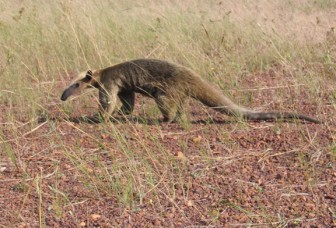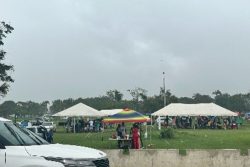The Southern Tamandua or Tamandua (Tamandua tetradactyla) is classified as a “true anteater”; other true anteaters in Guyana include the Giant Anteater and Silky Anteater, both of which have been featured in this column previously.
To be a true anteater is to have no teeth, only a long, tube-like snout with a long tongue. This nose and tongue is used to reach into inaccessible crevices to trap insects with its sticky saliva. True anteaters have small eyes and ears and powerful hooked front paws that are used to rip apart ant and termite nests. ![]() Their front paws are curved in the extreme that they must walk on the outside of their hand which has a thickened paw. As their front paws are so shaped and because they have no teeth, mother anteaters cannot pick up their young; the young Tamandua must crawl up onto the mother’s back by itself.
Their front paws are curved in the extreme that they must walk on the outside of their hand which has a thickened paw. As their front paws are so shaped and because they have no teeth, mother anteaters cannot pick up their young; the young Tamandua must crawl up onto the mother’s back by itself.

The Tamandua is all of this and more; it is a medium-sized anteater in general, but the size of the adult animal varies widely depending on its environment so it grows between 37 cm and 67 cm, and can weigh between 3.6 kg and 8.4 kg. Likewise, the colour of the animal is also variable but in general, the head, legs and hind parts are a pale golden yellow with a black ‘vest’ over the belly, lower back and over the shoulder.
The individual in the photo here is a light coloured specimen which was seen in the Rupununi Savanahs near Karanambu Ranch. The Tamandua has a long, prehensile tail which is naked at the tip, which is used as a fifth limb to steady itself when navigating and foraging in the tree tops.
The Tamandua is mainly solitary, nocturnal (active at night) and aboreal, (spends most of its time in the trees) where it forages for ants, termites and bees nests which it rips apart with its strong foreclaws. It prefers forests beside water courses and understory where its prey may be concentrated.
The Southern Tamandua is widespread in its range but generally uncommon and the IUCN (the International Union for Conservation of Nature and Natural Resources) Redlist states Tamandua as “least concern” and also states that the population trend (information about growth or disappearing population) for this animal is “unknown”.
Rain forests are rich in biodiversity and are home to many different plants and animals as well as indigenous communities. Humans, even those who don’t live in the rain forest, rely on it for resources such as building materials (wood and lianas), medicine and fruits.
Rain forests also provide essential environmental services for life on earth; they create soil as well as prevent soil erosion, produce oxygen though photosynthesis, maintain clean water systems, and are a key defence against climate change.
The Iwokrama Rain Forest is 371,000 hectares, located in the heart of Guyana. Our mission is to develop strategies for conservation and sustainable development for local people in Guyana and the world at large. We are involved in timber, tourism and training. Come and visit us in the rain forest or at http://www .iwokrama.org.










